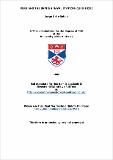Files in this item
Peru and the British naval station (1808-1839)
Item metadata
| dc.contributor.author | Ortiz-Sotelo, Jorge | |
| dc.coverage.spatial | 310 p. | en_US |
| dc.date.accessioned | 2012-07-10T09:52:41Z | |
| dc.date.available | 2012-07-10T09:52:41Z | |
| dc.date.issued | 1998 | |
| dc.identifier.uri | https://hdl.handle.net/10023/2958 | |
| dc.description.abstract | The protection of British interests in the Pacific was the basic reason to detach a number of Royal Navy's vessels to that Ocean during the Nineteenth Century. There were several British interests in the area, and an assorted number of Britons established in Spanish America since the beginning of the struggle for Independence. Amongst them, merchants was perhaps the most important and influential group, pressing on their government for protection to their trade. As soon as independence reached the western coast of America, a new space was created for British presence. First Valparaiso and afterwards Callao, British merchants were soon firmly established in that part of South America. As had happened in the Atlantic coast, their claims for protection were attended by the British government through the Pacific Squadron, under the flag of the Commander-in-Chief of the South American Station, until 1837, when it was raised to a separate Station. During the period covered by this research (1808-1839), Peru came through three crucial moments: the Wars of Independence, the initial years as a republic, and its confederation with Bolivia under the rule of Santa Cruz. Accordingly, the country shifted from being ruled by a strong authority, as the viceroy; to became a highly unstable republic, first because the War of Independence itself, and afterwards by reason of internal disputes amongst the military. British merchants already established in Rio de Janeiro, Buenos Aires and Valparaiso, considered Peruvian as a very profitable market, and consequently tried by every possible way to open it to foreign trade. Following the independence, in 1821, this market was officially opened, but it did not matched what British merchants expected. Potential buyers were too small in number and a reaction from local merchants proved efficient enough to maintain a high taxation on foreign goods. Even when British merchants reacted against these official policy, namely Protectionism, they were unable to obtain a more aggressive support from their government. Other British interests in Peru were built around a loan granted by a number of British investors in 1822, and some further investments on mining. Even when this time was a period in which Great Britain had achieved a paramount position in industry, commerce, naval and several other fields, its government maintained its policy of "free hands" towards the new republics in America. Consequently, British consular agents, as well as British Captains, devoted their mains efforts to kept British trade as safe as possible, and to protect their national from abuses committed by local authorities. This thesis aims to study how well the Royal Navy, through the Pacific Squadron and afterwards the Pacific Station, protected British subjects and interests in Peru, between 1808 and 1839. The research focused in the effectiveness of that naval presence, discussing how it was affected by local circumstances, the number of vessels available, the urgencies of transport of treasure and the limitations associated to operate without a shore base. | en_US |
| dc.language.iso | en | en_US |
| dc.publisher | University of St Andrews | |
| dc.subject.lcc | DA88.7P3O8 | |
| dc.title | Peru and the British naval station (1808-1839) | en_US |
| dc.type | Thesis | en_US |
| dc.type.qualificationlevel | Doctoral | en_US |
| dc.type.qualificationname | PhD Doctor of Philosophy | en_US |
| dc.publisher.institution | The University of St Andrews | en_US |
This item appears in the following Collection(s)
Items in the St Andrews Research Repository are protected by copyright, with all rights reserved, unless otherwise indicated.

